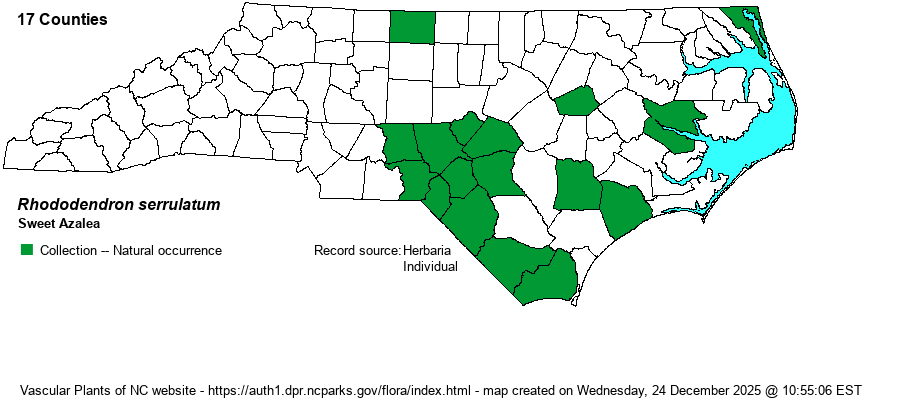| Author | (Small) Millais | |
| Distribution | Essentially just the Coastal Plain, and found primarily in the Sandhills. Scattered specimens from there northeastward to the VA line and south to Onslow County. A specimen for Rockingham County in the northern Piedmont (mapped by RAB) is highly suspect and needs checking. Note that Weakley's range description for this species states that the occurrence R. serrulatum in NC and SC is "uncertain." He probably means that the known county distribution is uncertain or not well worked out.
This recently split species, from R. viscosum, has a much more restricted range than that species -- occurring north only to southeastern VA, south to central FL, and west to LA. The Digital Atlas of Virginia Flora website shows records for most southeastern counties, as well as a similar range for the very similar R. viscosum. | |
| Abundance | Common in the Sandhills. Abundance farther eastward and north to the VA line is not as certain, owing to confusion with R. viscosum. However, perhaps uncommon to locally fairly common in areas with wet savannas eastward to Onslow County. As it occurs supposedly throughout southeastern VA, it likely is present in most eastern NC counties as well. Extremely rare in the Piedmont, if correctly identified. | |
| Habitat | This is a species of acidic Coastal Plain wetlands, especially prominent in Sandhills streamhead ecotones and seepages. It also grows in wet savannas. Apparently it is found in somewhat more acidic soils in the Coastal Plain than is R. viscosum. |
| Phenology | Blooms slightly earlier than the similar R. viscosum -- in late May and June (as opposed to June and July for R. viscosum). Fruits from July to October. | |
| Identification | This is a deciduous shrub that grows from 2-6 feet tall (reportedly taller but those plants likely confused with R. viscosum), often in dense stands in Sandhills pocosins. The height of plants is short because recurring fires keep them so, unlike plants of R. viscosum which usually inhabits wet swamps. As with R. viscosum, it has quite shiny, elliptical, dark green leaves, with very fragrant white flowers. The inside of the corolla tube is glabrous in this species, as opposed to pubescent in R. viscosum. This character isn't visible without opening a flower, but the flower tube is greater than twice as long as the five lobes; in R. viscosum, the tube is less than twice as long as the lobes. Also, the winter buds of R. serrulatum have 15-20 scales, as opposed to 8-12 (to rarely 15) scales in R. viscosum. | |
| Taxonomic Comments | As indicated above, Weakley (2018) recently has considered this taxon as a valid species. Most references have treated this taxon either as a variety of R. viscosum -- as R. viscosum var. serrulatum -- or not as a valid taxon at all, and subsumed it within R. viscosum.
| |
| Other Common Name(s) | Clammy Azalea, Hammocksweet Azalea | |
| State Rank | [S4?] | |
| Global Rank | GNA | |
| State Status | | |
| US Status | | |
| USACE-agcp | | |
| USACE-emp | | |

